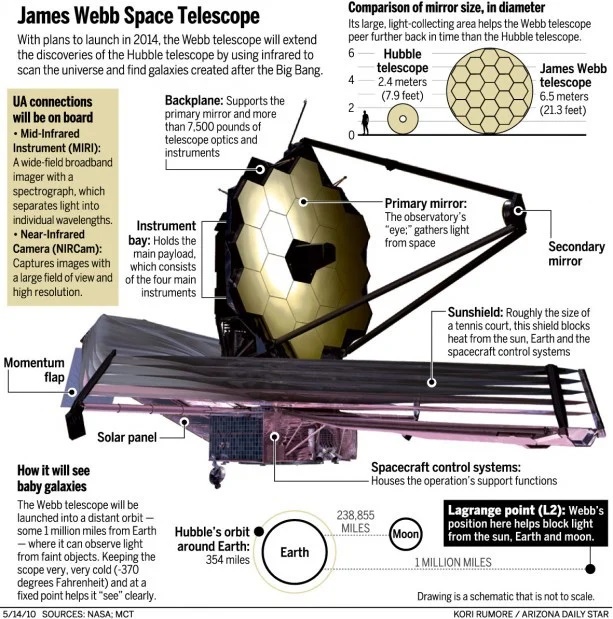- Home
- Prelims
- Mains
- Current Affairs
- Study Materials
- Test Series
NASA’s Webb Telescope and the first look at the universe from 13 billion years ago
Recently, National Aeronautics and Space Administration’s (NASA) released a set of images and science products of five different regions of the sky, taken with the James Webb Space Telescope.
-
It includes a galaxy cluster which appeared 4.6 billion years ago.
-
It is the deepest and finest infrared image of some of the most distant and oldest galaxies ever discovered.
-
These characteristics will aid scientists in learning more about each of these ancient galaxies'' mass, age, history, and composition.
James Webb Space Telescope
-
-
The telescope is the result of an international collaboration between NASA, the European Space Agency (ESA) and the Canadian Space Agency which was launched in December 2021.
-
It is currently at a point in space known as the Sun-Earth L2 Lagrange point, approximately 1.5 million km beyond Earth’s orbit around the Sun.
-
The Lagrange Point 2 is one of the five points in the orbital plane of the Earth-Sun system.
-
Named after Italian-French mathematician Josephy-Louis Lagrange, the points are in any revolving two-body system like Earth and Sun, marking where the gravitational forces of the two large bodies cancel each other out.
-
Objects placed at these positions are relatively stable and require minimal external energy or fuel to keep themselves there, and so many instruments are positioned here.
-
-
It''s the largest, most powerful infrared space telescope ever built.
-
It''s the successor to Hubble Telescope.
-
It can see backwards in time to just after the Big Bang by looking for galaxies that are so far away that the light has taken many billions of years to get from those galaxies to our telescopes.
-

-
Objectives:
-
It will examine every phase of cosmic history: from the Big Bang to the formation of galaxies, stars, and planets to the evolution of our own Solar System.
-
The goals for the Webb can be grouped into four themes.
-
The first is to look back around 13.5 billion years to see the first stars and galaxies forming out of the darkness of the early universe.
-
Second, to compare the faintest, earliest galaxies to today’s grand spirals and understand how galaxies assemble over billions of years.
-
Third, to see where stars and planetary systems are being born.
-
Fourth, to observe the atmospheres of extrasolar planets (beyond our solar system), and perhaps find the building blocks of life elsewhere in the universe.
-
-
Difference between Hubble & James Webb Telescope
-
Wavelength:
-
The James Webb Space Telescope would be observing infrared radiations most primarily covering between 0.6 to 28 microns.
-
Hubble’s work involved watching the ultraviolet and the visible spectrum of light. It observes the range of 0.8 to 2.5 microns.
-
-
Orbits:
-
Webb Telescope would not be orbiting the Earth. It would be orbiting the sun from 1.5 million kilometres away from the Earth.
-
Hubble orbits the Earth at an altitude of 575 kilometres from it.
-
-
Vision:
-
As per NASA, Hubble can see the smallest and the newest of all galaxies.
-
Webb would be able to see the Newborn galaxies as well.
-
Webb''s near and mid-infrared instruments would be helpful in studying the first formed galaxies and exoplanets.
-
Other Space Exploration Missions
-
Pioneer
-
It was the first spacecraft to visit the solar system''s most photogenic gas giants, Jupiter and Saturn.
-
Pioneer 10 was the first probe to travel through the solar system''s asteroid belt, a field of orbiting rocks between Mars and Jupiter.
-
-
Voyager
-
Shortly after the Pioneers made their flybys, the Voyager 1 and Voyager 2 probes followed. They made many important discoveries about Jupiter and Saturn, including rings around Jupiter and the presence of volcanism on Jupiter''s moon.
-
Voyager 1 is currently the farthest man-made object from Earth, at more than a hundred times the distance from the Earth to the sun, and more than twice as far as Pluto.
-
-
Chandra
-
Since 1999, the Chandra X-ray Observatory has been scanning the skies in X-ray light, looking at some of the most distant and bizarre astronomical events.
-
Because Earth''s pesky atmosphere blocks out most X-rays, astronomers couldn''t view the universe in this high-energy, short-wavelength light until they sent Chandra up to space.
-
-
SPHEREx’s
-
The Spectro-Photometer for the History of the Universe and Ices Explorer (SPHEREx) is a planned two-year mission that will survey the sky in optical as well as near-infrared light which, though not visible to the human eye, serves as a powerful tool for answering cosmic questions.
-
It would be launched in 2024.
-
Astronomers will use the mission to gather data on more than 300 million galaxies, as well as, more than 100 million stars in our own Milky Way.
-









 Latest News
Latest News
 General Studies
General Studies